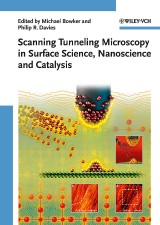Details
Scanning Tunneling Microscopy in Surface Science, Nanoscience, and Catalysis
1. Aufl.
|
138,99 € |
|
| Verlag: | Wiley-VCH (D) |
| Format: | |
| Veröffentl.: | 11.11.2009 |
| ISBN/EAN: | 9783527628834 |
| Sprache: | englisch |
| Anzahl Seiten: | 258 |
DRM-geschütztes eBook, Sie benötigen z.B. Adobe Digital Editions und eine Adobe ID zum Lesen.
Beschreibungen
Here, top international authors in the field of STM and surface science present first-class contributions on this hot topic, bringing the reader up to date with the latest developments in this rapidly advancing field. The focus is on the nanoscale, particularly in relation to catalysis, involving developments in our understanding of the nature of the surfaces of oxides and nanoparticulate materials, as well as adsorption, and includes in-situ studies of catalysis on such model materials. <br> Of high interest to practitioners of surface science, nanoscience, STM and catalysis.
Preface<br> CHIRALITY AT METAL SURFACES<br> Introduction<br> Surface Chirality Following Molecular Adsorption<br> Chiral Amplification and Recognition<br> Conclusions<br> THE TEMPLATE TO NANOSTRUCTURED MODEL CATALYSTS<br> Introduction<br> Surfaces as Two-Dimensional Templates<br> STM Imaging of Oxide Films<br> STM Imaging of Metal Particles on Oxide Films<br> Template-Controlled Growth of Model Catalysts<br> Conclusions<br> IN SITU STM STUDIES OF MODEL CATALYSTS<br> Introduction<br> Instrumentation<br> Visualizing the Pathway of Catalytic Reactions<br> Metal Surfaces at High Pressures<br> In Situ Studies of Supported Model Catalysts<br> Outlook<br> THEORY OF SCANNING TUNNELING MICROSCOPY AND APPLICATIONS IN CATALYSIS<br> Catalysis and Scanning Tunneling Microscopy<br> Image Formation in an STM<br> Simulating Tunneling Currents<br> Simulating Chemical Reactivity<br> Catalytic Water Production<br> Outlook<br> CHARACTERIZATION AND MODIFICATION OF ELECTRODE SURFACES BY IN SITU STM<br> Introduction<br> In Situ STM: Principle, Technical Realization and Limitations<br> Imaging Simple-Crystal Surfaces of Catalytically Relevant Systems<br> Strategies for Nanostructuring Surfaces<br> STM IMAGING OF OXIDE NANOLAYER MODEL SYSTEMS<br> Introduction<br> Experimental Aspects and Technical Developments<br> Case Studies: Selected Oxide-Metal Systems<br> Synopsis and Outlook<br> SURFACE MOBILITY OF ATOMS AND MOLECULES STUDIED WITH HIGH-PRESSURE SCANNING TUNNELING MICROSCOPY<br> Introduction<br> Characterization of Surface Mobility of Molecules and Atoms<br> High-Pressure STM Technique and Instrumentation<br> Mobility and Flexibility of Catalyst Surfaces at High-Pressure<br> Adsorbate Mobility During Catalytic Reactions<br> Summary<br> POINT DEFECTS ON RUTILE TiO2(1 1 0): REACTIVITY, DYNAMICS, AND TUNABILITY<br> Introduction<br> Methods<br> Water Dissociation at Oxygen Vacancies and the Identification of Point Defects<br> O2 Dissociation at Oxygen Vacancies<br> Diffusion of Oxygen Vacancies and Surface Hydroxy<br> Tuning the Densities of Oxygen Vacancies and Surface Hydroxyl on TiO2(1 1 0)<br> Outlook
"The book covers a wide range of aspects of STM studies on catalysis: methodology, instrumentation, experiment, and theory. An index at the end of the book enables readers to promptly locate the content of their interests. The book contains numerous high-resolution STM images, which renders a pleasant reading experience as well as stimulates appreciation of the power of STM. Therefore, I highly recommend that this book have a space on your bookshelf." (<i>Microscopy and Microanalysis</i>, February 2011)<br /> <br /> "A very useful addition to your bookshelf . . . Whether you read only the one chapter related to your area or the entire book . . ., you are bound to learn something new about this unique instrument and its continued impact on nearly every aspect of surface science and nanoscience as well as its ever-increasing contributions toward understanding catalysis." (<i>JACS</i>, 2010)
Michael Bowker has worked in surface science and catalysis for the last 25 years and has approximately 250 publications. He has worked in both industry (ICI) and academia. He leads the Heterogeneous Catalysis and Surface Science group in Cardiff, consisting of nine academic members of staff and 70 researchers. He founded the Wolfson Nanoscience Laboratory at Cardiff in 2006 and is Deputy Director of the recently established Cardiff Catalysis Institute. His research has focused on adsorption and surface reactivity, ranging from theo-retical studies of the effect of sintering, to selective oxidation catalysis, to studies of adsorption on well-defined surfaces. He has used STM for 20 years to study various aspects of surface structure and reactivity, pioneering the use of high temperature STM in this field. The group continues to focus on aspects of surface science and catalysis, now extending to nanoengineering and bio-surface interactions.<br> <br> Philip R. Davies studied chemistry and mathematics in Southampton University. Undergraduate projects on surface electrochemistry with Prof. Laurence Peter and the modelling of adsorption at fractal surfaces with Professor Dominic Tildesley stopped him from becoming an accountant and led to his interest in surface processes. After graduating with double honours in 1986, he moved to Cardiff to study reactions at surfaces with surface-sensitive spectroscopy under the supervision of Prof. Wyn Roberts. After being awarded a PhD, he was appointed to a lectureship in the Department of Chemistry at Cardiff and continued to study surface reaction mechanisms and particularly the role of short lived intermediates. Since 1997, his interests have centred largely on the influence of local atomic structure on reaction mechanisms studied with scanning probe microscopies.
Since the scanning tunneling microscope allows scientists to visualize regions of high electron density and hence infer the position of individual atoms and molecules on the surface of a lattice, STM nowadays has numerous applications in nanoscience, catalysis and surface science.<br> Here, top international authors in the field of STM and surface science present first-class contributions on this hot topic, bringing the reader up to date with the latest developments in this rapidly advancing field. The focus is on the nanoscale, particularly in relation to catalysis, involving developments in our understanding of the nature of the surfaces of oxides and nanoparticulate materials, as well as adsorption, and includes in-situ studies of catalysis on such model materials.<br> Of great interest to practitioners of surface science, nanoscience,STM and catalysis.



















